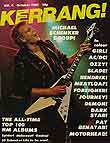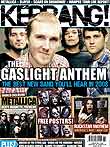
i used photoshop to edit all of the photographs used in my media text, the tools i used the most were, the polygon lasoo tool, to take away the background of some of the photographs, the auto colour, auto brightness and auto contrast, to make the photographs look like they belong in the desired genre of rock/punk. i also used photoshop to make all of my falshes, puffs and other additional things that were added to my cover, contents page and double page spread. I also used photoshop to make my masthead for the cover of my magazine, i had a number of attempts at different mastheads,and i finally decided on the one i used because i liked the effect it had with the rest of the cover and the photographs. i found the use of photoshop easy to get used to all the tools,options,layers etc.
an example of something from my contents page that i created in photoshop:
I created this by using a plain sans serif font and then removing the background so that the writing was the only thing on the layer, i then used the rubber on a high oppasitiy to make it look aged, or like it had been stamped onto the page, this effect is used alot in 'Kerrang!' magazine, so i used it my work as a referance back to the studied magazine. I used this effect numerous times in my work so that the rock/punk theme went through my whole media text.
I used InDesign to put all my work together, again using layers, but this time i used different frames for different things such as, background, central image, masthead, featured articles, puffs and banners. I found InDesign easy enough to use, the frames and layers made it really easy to handle and keep track of where things are/ should be on the document.
Production Process for Cover:
I started by looking at a number of kerrang magazines, i looked at all the techniques used to make the cover more appealing to an audience and made a note of them so i could use them in my work,
Also while i was working i'd have these example open on the screen so i could make comparisons to be sure my cover looked professional and eye catching.
The first part of my cover that i did was the background:
i chose not to use this masthead becuase i thought it looked really plain and not very eye catching and professional. I also don't think it fits very well with the rock genre as it is very bright and happy looking.I then decided to add something to it to see if i could improve it, i came to the conclusion that it was too bold and has no effect to it to make it eye catching and i think it looks really unprofessional and still doesn't fit with the rock genre, I could see this because it doesn't look like the masthead on any of my studied magazine covers.

My final masthead, In my opinion the plain San Serif text looks really effective now that i've added a drop shaddow and made it look three dimentional, this will make it more eye catching and more likely to sell. It looks professional and neat, unlike my first two mastheads that look dull and unprofessional and don't match the Gothic genre magazines that I'd looked at for inspiration..
Once i'd Chosen my masthead i went back to the background that i'd designed and added it to it, i also added the frames i'd need for photographs and other copy
I also added the barcode and price because it was the smallest part on the page and i didnt want to forget about it because its one of the key parts on the cover. I used InDesign to put all of the frames in the positions I wanted them for my photographs and other copy for the cover.
I then started editing the images to put on the cover, I used photoshop to edit all of my photographs
Final Cover-
Final Cover-
I'm really happy with how my cover turned out, In my opinion it looks really professional and neat, I think that if it were a really published magazine that it would have a good selling rate.
Like the magazine covers that I studied I decided to analyse my own cover, showing all of the techniques i used, taken from my inspired covers.
Contents page production process-
I looked at a number of contents pages from other magazines and looked at the different layouts, colour schemes and techniques used on them.
I noticed that the contents pages aren't very busy, showing that its more informative than made to attract the audience's attention
I then looked at 'Kerrang!' magazine contents pages as this was the main magazine I got my inspiration from,
I've notice that unlike the other contents pages I'd looked at, the Kerrang! ones are very busy and upbeat, this is a representation of the rock/punk social group, showing the energetic, upbeat nature of them.
I made my contents page using InDesign, in the same way I made my cover, I used Photoshop to edit all of my photographs and then used InDesign to add the pictures to the background, again using frames to keep my work organised.
My final contents page turned out to look a lot like the ones I studied which I'm very pleased with.
I carried on the colour palette used on my Cover, I used several techniques used on the contents pages that I'd studied, for example, I used the split page and had a photograph across the whole top half of the page, along with the 'Contents' title and a featured article, I also used the technique of having a box with the name of my magazine and 'THIS WEEK' which was used on the Kerrang contents pages that I studied. I used polariod style photographs to create the effect that things had been stuck onto the page, much like the peeling sticker I used on my cover.
Double Page Spread Production Process-
I looked at a number of double page spreads from different magazines to see what the different magazines did, i notice that there is usually a lot of photographs and the title usually takes up the whole top part of one page with the text below it and then images on the other page, this makes it look really appealing because it looks like there's not a lot of text and it can be read easily, i also noticed that the first letter of the text it much bigger and in a different colour than the rest of the text on the page.
I'm really happy with how my double page spread turned out, I used several techniques used in the double page spread that I looked at, which means I used techniques used in non rock/punk magazines, I did this to give it a girly feel because the person in the interview seems very girly, therefore making it easy to tell just by looking at the cover. I also carried on using the technique of making things look like they're stuck on the page, i did this with two polariod photographs at the top of the page and a post-it note at the bottom of the page with i little bit of extra information that wasn't mentioned in the interview.
The interview was inspired by an interview of Taylor Momsen in 'Sugar' magazine which is a very girly magazine, i chose to do a girly interview to countertype with what people assume the rock/punk social group to be, therefore showing it through my work that there's more to them than you think.
















































































